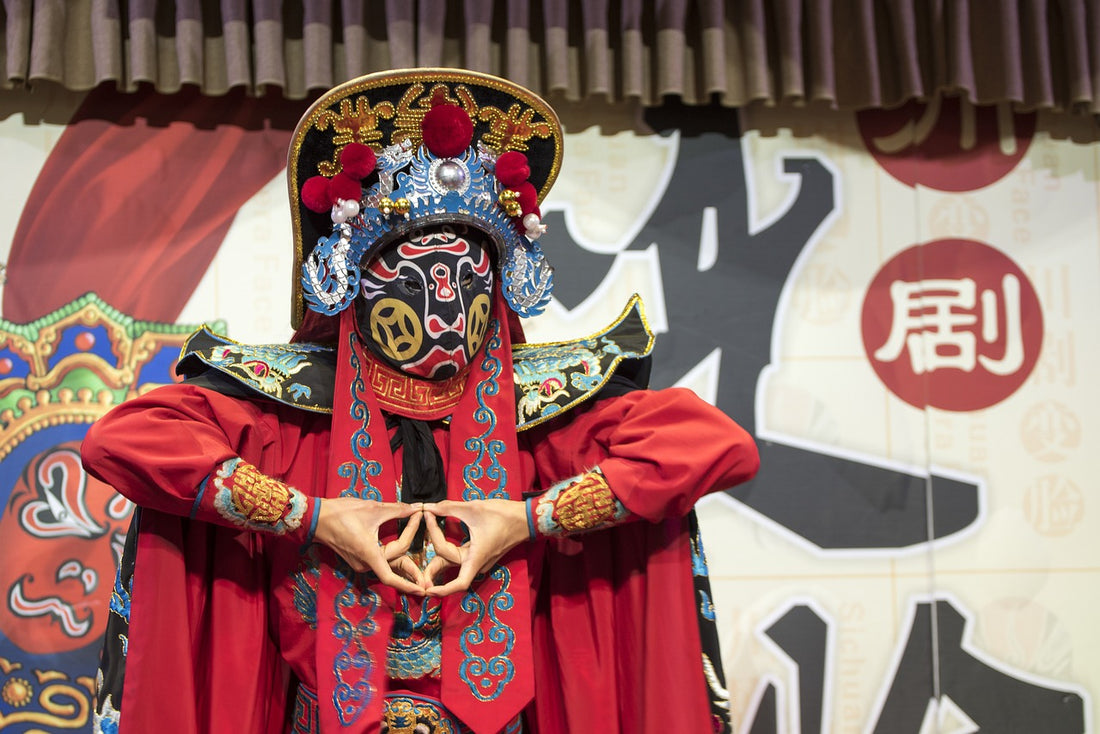
The Chinese Theory of Colors: Meaning, Harmony and Symbolism
Share
The Chinese theory of colors is a fascinating part of Chinese culture and philosophy, in which colors have not only aesthetic, but also symbolic, spiritual and energetic meanings. For thousands of years, colors have played an essential role in Chinese art, architecture, fashion and everyday life. The theory of colors has become deeply rooted in the Chinese worldview, particularly through Daoist philosophy and the five-element theory (wood, fire, earth, metal, water).
In this blog post, we delve into the world of Chinese color theory and examine the meaning of individual colors as well as their connection to the five elements and the Yin-Yang philosophy.
The Basics of Chinese Color Theory: The Five Elements and Their Colors
In Chinese philosophy, life is embedded in a continuous cycle, which is represented by the five elements theory. Each of these elements is assigned a color that symbolizes certain energies and characteristics.
1. Wood – Green
Green stands for growth, vitality and new beginnings. It is the color of spring and symbolizes vitality and flexibility. In the Chinese color wheel, green is closely associated with the east and the morning. Wood also represents development and forward movement.
2. Fire – Red
Red is the color of fire and symbolizes luck, joy and prosperity. In China, red is traditionally used in festivals and celebrations, especially weddings and the Chinese New Year, to bring good luck and harmony. In terms of elements, fire represents warmth and transformation and is closely associated with the south and summer.
3. Earth – Yellow
Yellow represents the earth, the ground and the center. In Chinese history, yellow was an imperial color that symbolized power and dominion. As the color of the earth, yellow also stands for stability, nourishment and harmony. It is considered a connecting element that brings the other colors together.
4. Metal – White
White is the color of metal and represents purity, clarity and strength. Metal stands for clear thinking, creating structure and letting go of superfluous things. This color is often associated with the West and autumn. Unlike in the West, where white is more associated with weddings and joy, in China it has a special meaning as the color of mourning and the purity of farewell.
5. Water – Black
Black, the color of water, represents depth, calm and mystery. It is the color of wisdom and silent knowledge. Water symbolizes the element that is flexible and can change form - like water that flows and adapts. It represents the north and winter and is a symbol of introspection and reflection.
Colors and Yin-Yang: Balance and Opposites
The principle of Yin and Yang is central to Chinese philosophy. Yin and Yang describe the polarity of life, the interplay of opposites that complement each other and form a unity. The theory of colors is also based on this principle.
- Yin colors are traditionally cool, dark and calming, like black and blue. They represent night, water, winter and the quiet, introspective aspects of life.
- Yang colors, on the other hand, are bright, warm and energetic, like red and yellow. They symbolize day, sun, fire and the active, lively aspects of life.
In Chinese color theory, the balance between these two poles creates harmony. This applies to interior design and fashion as well as to personal expression and well-being. For example, people often try to design rooms so that Yin and Yang balance each other out, creating a harmonious atmosphere.
Colors in Chinese Culture and Everyday Life
The meaning of colors also plays a major role in everyday life in China. Here are some examples:
- Red is ubiquitous at weddings as it is believed to bless the couple with luck and prosperity. Red envelopes containing gifts of money are also common at festivals.
- White, on the other hand, is worn as the color of mourning at funerals. Since white stands for farewell and purity, it creates a solemn atmosphere of remembrance.
- Yellow has historical significance as an imperial color and is associated with prestige and dignity. It was only worn by the emperor in ancient China and remains a symbol of honor.
- Green is valued as a positive and natural color, although it can also have a negative meaning in connection with jealousy or envy.
- Although blue and black are less common in celebrations, they are often worn as respectful and serious colors, especially in official contexts.
Color Choice and Feng Shui
The Chinese theory of colors is also used in the art of Feng Shui, the theory of harmonizing people with their environment. Feng Shui places great importance on the selection and placement of colors in a room in order to positively influence the flow of energy (Qi). The five elements and their colors help to find the right energy flow for different rooms.
- Green elements promote creativity and renewal and are therefore well suited for work rooms and rooms where fresh ideas are needed.
- Red elements bring energy and dynamism into the room – ideal for living rooms and dining rooms where people meet socially.
- Yellow and earthy colors promote stability and well-being and go well with rooms where you seek peace and relaxation, such as the living room or kitchen.
- White accents give rooms clarity and order and are therefore often found in work or study spaces.
- Black and dark blue tones bring calm and depth to rooms used for relaxation, such as the bedroom.
Conclusion: The deep symbolism of Chinese color theory
The Chinese theory of colors is much more than an aesthetic or a question of taste - it connects people with nature, the seasons and spirituality. Colors are not chosen at random, but carry meanings and create energies that influence our lives in many ways. The harmony of colors, based on the five-element theory and the yin-yang principle, brings balance and well-being into everyday life.
By understanding this ancient theory of color, you can still find inspiration for your own choice of colors in your home, in your clothing, and even in your life. Chinese color theory shows us how colors not only please the eye, but can also touch the heart and mind.
